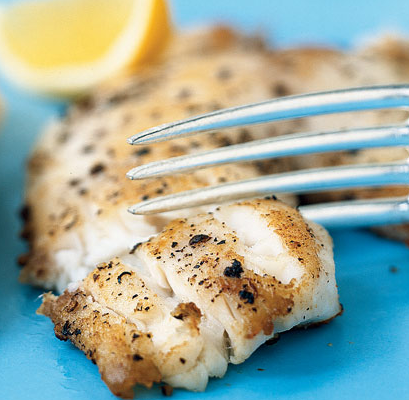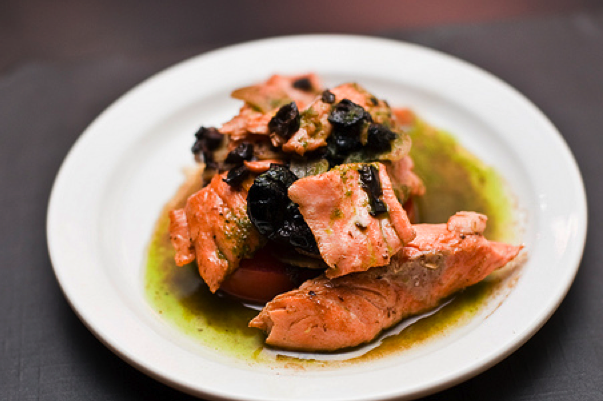Fish is good for you! It’s low in saturated fat, good for your heart, and tastes great. It’s true that large ocean predators are high in mercury and chemicals from plastics. But the benefits of fish are bigger than the risks, according to studies. So we should eat it, right?
But what about the environmental costs? Commercial fisheries are responsible for depleting stocks of targeted fish. They destroy ocean habitat as well as the unfortunate creatures in bycatch. Farms can cause problems like habitat destruction, pollution, increased parasites and illnesses in ecosystems. Escaped farm fish may mess with the genetics of wild fish populations.
What’s a responsible pescavore to do?
It all boils down to informed decision making. There are smart and sustainable choices out there—they just take a little research. And hey! Your friends at Simple, Good and Tasty are here to do the footwork for you. Here are some strategies for choosing, and improving access to, sustainably harvested seafood.
Rule #1: Pole and line is just fine.
Fishing with a pole, hook and line, or trolled line leaves almost no trace on the environment. There’s little or no bycatch, either. Fish caught this way is more expensive, but it is out there. Tobago Wild is one company that supplies ocean fish caught by hand. Tobago Wild sells directly to high-end restaurant chefs around the United States, and the fish is also available at Minneapolis’s own Wedge Co-op.
 Tilapia Photo from www.abouttilapia.com/If you prefer to eat closer to home, then think about this: a fish caught locally by a licensed angler is a pretty good choice. The license fees go toward managing natural resources. And if you catch the fish yourself, then you know exactly how fresh it is.
Tilapia Photo from www.abouttilapia.com/If you prefer to eat closer to home, then think about this: a fish caught locally by a licensed angler is a pretty good choice. The license fees go toward managing natural resources. And if you catch the fish yourself, then you know exactly how fresh it is.
Rule #2: Check for papers.
In the last ten years, different nonprofit organizations have developed standards and certifications for wild-caught and farm-raised fish and shellfish. The programs are still new and working to establish themselves. So absence of a certificate does not mean that the food is not sustainable. But the presence of one is extra assurance.
Certification from London-based Marine Stewardship Council (MSC) is an indicator that the wild-caught fish you’re buying should be from a well-managed fishery. The certification includes chain-of-custody documentation. This paper trail proves the fish in the grocer’s case right in front of you really came from a boat operating in a certified fishery.
Criticisms of the MSC include concerns that the certification process is flawed. Research and conservation groups have raised objections to the certification of Alaskan pollock and New Zealand hoki fisheries. So the certification is no rubber stamp. But in absence of another proof of seafood’s source, it’s at the very least a good start.
Whole Foods is one of the handful of U.S. retail outlets to carry MSC chain-of-custody certification. According to Blair McKinley, seafood team leader at Minneapolis’s Calhoun location, Whole Foods’s national policy is to carry as many kinds of certified seafood as possible. As one of the longest-serving seafood team leaders in the company, McKinley’s personal opinion is that the certification is valuable for bringing attention to responsible stewardship. “[Resource management] has to improve, because the populations of our fish are going down,” he commented.
Most stores don’t sell under the MSC seal, but they can still tell you where their goods come from. In Minneapolis, Coastal Seafoods retail manager Damon Holston explained that the certification costs money. It doesn’t seem right to him that he should have to pay to display the MSC symbol; and it doesn’t make good sense for his store. So while Coastal does purchase fish from at least one certified supplier, they cannot advertise it as such. They can, however, find out the origins of anything in their shop. Some products may be caught in certified fisheries.
For farmed fish, a similar certification and chain-of-custody arrangement is administered by the Aquaculture Certification Council (ACC). The ACC enforces aquaculture best practices guidelines developed by the Global Aquaculture Alliance (GAA). The ACC’s traceability database records each transaction among farms, processors, and buyers.
For now, the organization certifies shrimp, tilapia, and catfish operations. (Almost all of the certified farms are in Southeast Asia or South America.) You will not see the ACC’s seal on seafood products in a store; the certification program does not extend to the retail level. But if you can talk to the fish buyer at your grocery or restaurant, you should be able to find out if the products were purchased from certified suppliers. (Whole Foods works closely with the ACC and is about to start carrying certified tilapia.)
 Photo Credit: Kate NG SommersRule #3: Ask some friends.
Photo Credit: Kate NG SommersRule #3: Ask some friends.
But be sure to ask the right friends—these three. The Monterey Bay Aquarium, Environmental Defense Fund, and Blue Ocean Institute have collaborated to research and write some handy guides. Each institute has a version designed for quick consultation when shopping or dining out. All three suggest choices, both wild caught and farmed, to embrace and avoid. They also make note of species with high mercury levels.
The Monterey Bay Aquarium is one of the world’s best. It’s recognized as an international leader in research on environment and fisheries. For ten years, their Seafood Watch program has led the charge in recognizing, mitigating—and hopefully reversing—the damage that fishing has done to our oceans. Their regional pocket guides and sushi pocket guide are updated regularly. They offer an online seafood guide for computers and mobile devices; they’ve also got an iPhone app.
Environmental Defense Fund works to find science-based, economically motivated solutions to environmental problems. They have pocket guides for fish and sushi. Their full seafood guide is available for computers or mobile devices.
If you have some time for research before you shop or dine, check out Blue Ocean Institute’s color-coded guide. It has information about fishing or farming conditions and notes which fisheries are MSC certified. Their sushi pocket guide is downloadable, but the regular seafood guide is available for order in batches of 500.
Rule #4: If you want it, say so.
When you’re out shopping or at a restaurant, there’s a single best thing you can do to let businesses know you want responsibly caught or raised fish and shellfish: tell them so. Tell the fishmonger or the waiter what you’re looking for. Ask which fishery or farm the seafood came from. Ask how it was raised or caught. Ask about standards for the farm or fishery, and ask who is monitoring those standards. If the waiter or counter person doesn’t know, request that s/he ask the chef or manager. If no one can tell you anything about the fish, consider changing your mind about what to have for dinner.
If chefs and grocery store managers notice people going out of their way to buy sustainable seafood, they will know their customers want it. What store or restaurant doesn’t like happy customers? So much the better if we can make the oceans a little happier, too.




